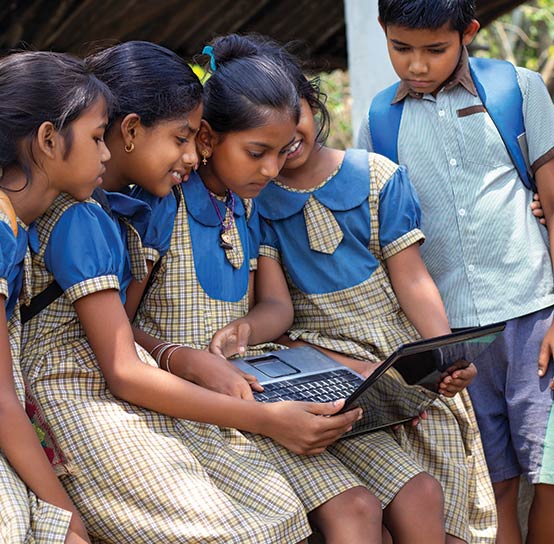-
Business Consulting
Our business consulting specialists offer a comprehensive blend of strategic advisory services. We assess the business, industry, operating model, synergy, skill sets and vision of the organisation and recommend the way forward
-
Digital Transformation Services
Grant Thornton’s digital transformation services help traditional businesses digitalise their business models with cloud technology, IoT consulting, app development and more DigiTech solutions.
-
Human Capital Consulting
Our Human Capital Consulting team harnesses technology and industry expertise to assist in constructing adaptable organisations with transparency, fostering productive and value-driven workforces, and inspiring employees to engage meaningfully in their tasks.
-
Production Linked Incentive Scheme
Production-linked Incentive Scheme by the Indian government is aimed at boosting manufacturing. Grant Thornton Bharat offers varied services across sectors to help businesses avail of this scheme.
-
Public Sector Advisory
Our Public Sector Advisory team has focused streams, aligned with the core priorities of the Government of India. We are responsible for providing innovative and customized technical and managerial solutions.
-
Tech Advisory
We have amalgamated Digital Transformation, IT Advisory & Information Management and Analytics into a new offering, DigiTech.
-
Direct Tax services
Our tax specialists offer a comprehensive blend of tax advisory, tax litigation, regulatory and compliance services, helping you navigate through complex business matters.
-
Indirect Tax Services
Get tax advisory service by leading tax firm Grant Thornton India. Our indirect tax services include advisory, compliance and litigation services for corporate, international and transaction tax
-
Transfer pricing services
Our transfer pricing services experts provide a range of services from provision of APA services to handling large global assignments including Country by Country reporting.
-
US Tax
At Grant Thornton, we help individuals and dynamic companies deal with US tax laws, which are one of the most complicated tax legislations across the world.
-
Financial Services - Tax
Best financial advisory services, tailored for small and large businesses by the experts having comprehensive knowledge of domestic laws and access to multifaceted tools to provide a valuable results.
-
Financial Reporting consulting services
Our experts have significant hands-on experience in providing IFRS/US GAAP services, end-to-end solutions and support services to fulfil financial reporting requirements.
-
Fund accounting and financial reporting
International operations often lack standardisation and have varied local reporting formats and requirements. Our experts can offer proactive insights, practical guidance, and positive progress and help meet regulatory timeframes.
-
Compliance and Secretarial Services
Our experts can assist in overhauling the entire compliance machinery of the organisation through evaluation of the applicable statutory obligations, monitoring of adequate governance controls, reporting and providing ongoing support.
-
Global People Solutions
As businesses transcend borders, both domestic and global considerations need equal attention. Our interim CFO and financial controller support services help organisations meet the business vision.
-
Finance and accounting outsourcing
Our accounting experts assist organisations in managing their accounting and reporting. Our dedicated Integrated Knowledge and Capability Centre (IKCC), allows us to service both the domestic and global markets efficiently and cost-effectively
-
Compliance Management System
We have automation solutions for you that will allow meeting government requirements and remain diligent, which when failed, can lead to penalties and loss in revenue.
-
IKCC: Grant Thornton's Shared Service Centre
The India Knowledge and Capability Centre (IKCC), aimed at delivering solutions by developing capabilities, has completed four years of its journey.
-
Global compliance and reporting solutions
At Grant Thornton Bharat, we meet the challenges of our clients and help them unlock their potential for growth. Our professionals offer solutions tailored to meet our clients’ global accounting and statutory reporting requirements. With first-hand experience of local reporting requirements in more than 145+ locations worldwide, we provide seamless and consistent international service delivery through a single point of contact.
-
Related Party Transactions Governance
Related Party Transactions Governance
-
Private Client Services
Private Client Services
-
Labour codes
Labour codes solutions help you transition through the new legislation. At Grant Thornton, we help businesses divide their approach to make sure a smooth transition.
-
Alerts
At Grant Thornton India, with the help of our tax alerts, we help to provide updates on how to minimise your tax exposure and risks.
-
Cyber
In today’s time, businesses have gone through large transformation initiatives such as adoption of digital technologies, transition to cloud, use of advanced technologies et al.
-
Governance, Risk & Operations
Our Governance, Risk and Operations (GRO) services encompass Internal Audit, Enterprise Risk Management, Internal Financial Controls, IT advisory, Standard Operating Procedures and other services.
-
Risk analytics
Grant Thornton Bharat’s CLEARR Insights is a state-of-the art data analytics platform that will help you in seamless data analysis and efficient decision-making.
-
Forensic & Investigation Services
The team of forensic advisory services experts consists of the best intelligence corporate experts, and fraud risk, computer forensic experts to deliver most effective solutions to dynamic Indian businesses.
-
ESG consulting
Grant Thornton Bharat offers holistic ESG consulting solutions for sustainable business outcomes. With industry expertise and AI technology, we drive long-term value.

-
Transaction Tax Services
Our transaction tax experts understand your business, anticipate your needs and come up with robust tax solutions that help you achieve business objectives ensuring compliance and efficiency
-
Deal Advisory
Unlike other M&A advisory firm in India, we offer deal advisory services and work exclusively with controlled and well-designed strategies to help businesses grow, expand and create value.
-
Due Diligence
Grant Thornton’s financial due diligence services are aimed at corporate looking for mergers and acquisitions, private equity firms evaluating investments and businesses/promoters considering sale/divestment.
-
Valuations
As one of the leading valuation consultants in India, Grant Thornton specializes in all the aspects of the process like business valuation services, financial reporting, tax issues, etc.
-
Overseas Listing
Overseas listing presents a perfect platform for mid-sized Indian companies with global ambitions. Grant Thornton’s team of experts in listings, work closely with clients during all stages.
-
Debt & Special Situations Solutions
Grant Thornton Bharat offers specialist debt and special situations consulting services, including restructuring, insolvency, and asset tracing solutions.
-
Financial Reporting Advisory Services
Financial Reporting Advisory Services
-
Financial Statement Audit and Attestation Services
Financial Statement Audit and Attestation Services

- Agriculture
- Asset management
- Automotive and EV
- Aviation
- Banking
- Education and ed-tech
- Energy & Renewables
- Engineering & industrial products
- FinTech
- FMCG & consumer goods
- Food processing
- Gaming
- Healthcare
- Urban infrastructure
- Insurance
- Media
- Medical devices
- Metals & Mining
- NBFC
- Pharma, bio tech & life sciences
- Real estate and REITs
- Retail & E-commerce
- Specialty chemicals
- Sports
- Technology
- Telecom
- Transportation & logistics
- Tourism & hospitality
-
India-UK
India-UK

India holds a special place on the global pharmaceuticals map. The sector has grown at a consistent pace to emerge as the third largest producer, by volume, in the world with a leading position in supply of generic drugs and low-cost vaccines.
Last couple of years have seen India’s pharma sector rise to the unprecedented challenge presented by the Covid-19 pandemic.
The domestic sector, currently estimated to be around $42 billion, is expected to grow in double digits to reach around $130 billion by 2030.
As we look to the future, Indian pharma and biotech companies will need to accelerate their efforts for the next stage of growth by strengthening presence across developed markets and ramp-up new product and technology capabilities through organic and inorganic routes.
The sector witnessed major disruptions due to the pandemic which has led players to shift focus towards de-risking of their supply chains and manufacturing operations. Additionally, capacity expansion in sensitive APIs, intermediates, biopharmaceuticals, and medical devices would be critical for growth.
India lags on innovation and R&D in pharma as compared to some of the large economies. Impetus on this front would unlock new opportunities for India on the global pharma value chain.
The government has undertaken several progressive initiatives to strengthen the domestic manufacturing ecosystem, such as the Production Linked Incentive (PLI) schemes, schemes for promotion of bulk drug parks, medical devices parks, among others.
Budget FY2022-23 is expected to build on the momentum and address key challenges faced by the sector to achieve the vision of ‘AatmaNirbhar Bharat’.
Focus on Capacity Expansion
Enhanced outlay on Production Linked Incentive (PLI) schemes will further encourage investments in capacity expansion for sensitive APIs, complex excipients, drug intermediates, biopharmaceuticals, manufacturing of vaccines and medical devices. Previously, Merchandise Exports from India Scheme (MEIS) benefits were available for specific pharma products under Foreign Trade Policy.
However, exclusion of the pharma sector under the Remission of Duties and Taxes Exported Products (RODTEP) scheme launched in January 2021 excludes pharma products from availing benefits, which might deteriorate working capital position. Identification and inclusion of specific pharma products in the revised list of products eligible for the RODTEP scheme would be beneficial for the sector.
Support Innovation
Due to the current situation and changing business dynamics, pharma entities need to focus on high-end innovation and that too within a short span of time. Therefore, pharma players must invest in the best of the technologies and employ top experts to stay ahead on the innovation curve.
Hence, the government of India should consider restoring a higher percentage of deduction for expenses incurred towards R&D under section 35 (2AB) of Income Tax Act. It would encourage innovation and R&D in the country. Currently, regulatory norms for clinical trials take a long time for products imported from developed countries.
Even for key products like vaccines, clinical trials and approvals might take more than one year. Streamlining regulatory requirements related to clinical trials without compromising risk would strengthen the sectors’ growth and reduce time to market. Additionally, lower GST for such clinical trials and research and development services would help to grow this sector.
Cost impact on taxation of royalty income from the use of Intellectual Properties (IPs) should be minimised at least during the initial few years to bring the latest technology to India.
Focus on Operational Efficiency
Clarification on ambiguity around allowability of market cost like free sample distribution to medical practitioners under the Income Tax law would put an end to protracted litigation in this sector. Even ambiguity prevailing with regards to availability of input tax credit under the Goods and Services Tax on expenses incurred for Corporate Social Responsibility needs clarification, not only for the pharma sector but beyond as well.
The Organisation for Economic Co-operation and Development has clarified Transfer Pricing perspective about adjustments of Covid-19 related expenses. However, clarification on a similar line from the authorities regarding Indian Transfer Pricing perspective would help ease its implementation.
Further, the extension of reduced tax rate of 15% u/s 115BAB under Income Tax Act to incentivise the existing entities for expansion and capital gains exemption on startup investments would not only help the pharma and medical devices sector, but the industry at large.
Guidance from the authorities on these key issues would enable businesses to focus on core activities, enhance operational efficiency and also offer cost-effective products which will improve the affordability aspect of healthcare.
Overall, concentrated focus on core sectors like pharma with quick implementation and resolution through the budget would reinforce India’s position as the preferred pharma manufacturing destination in the world.
This article was originally published on The Times of India.